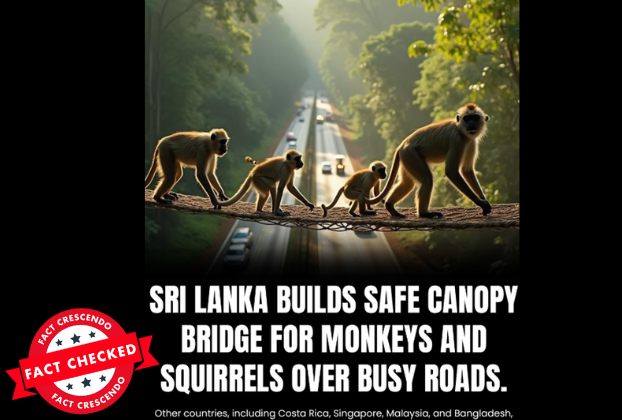There is often interest among the public in innovative ideas that aim to enhance the co-existence of humans and animals. One such move, touted as a novel idea implemented in Sri Lanka, purportedly claimed that the country was building rope canopy bridges to help monkeys and squirrels cross busy roads. Let’s look at these viral claims in detail.
Social Media Posts
Viral Facebook posts, shared primarily in English, claimed that Sri Lanka has installed rope canopy bridges made of durable ropes or netting over roads to provide safe passage for tree-living wildlife, including monkeys, squirrels, and the endangered purple-faced langur. It is said that bridges are strategically placed in high-traffic areas near forests like Sinharaja to reduce roadkill and maintain ecological connectivity across fragmented habitats. The infrastructure allows species to cross roads without descending to ground level, protecting them from vehicle strikes while preserving wildlife movement patterns.
Below is another instance of the same narrative and goes on to state that one such bridge has already been finalised on the Sigiriya-Inamaluwa road, and dozens are under construction in areas like Sinharaja and Aththidiya.
Similarly, we came across many other posts, which implied that the so-called “sky bridges” building was happening in large numbers in Sri Lanka.
Let’s look at the facts behind these claims.
Fact Check
In reality, however, Sri Lanka has implemented just one such bridge, and it was also not completed recently, but three years ago, back in 2022.
On the Sigiriya–Inamaluwa road, the Wildlife & Nature Protection Society (WNPS) and the Department of Wildlife Conservation erected a rope bridge in March 2022 to help endangered purple-faced langurs/monkeys and other treetop animals avoid road kills. As WNPS president Jehan Canagaretna explained to Ceylon Today in 2022, by building the bridge, they hope to reduce the number of road kills in that area in the future. The bridge uses two strong steel cables with nylon netting between them. Initially, the primates hesitated, but within days, purple-faced langurs began using the crossing, carrying infants on their backs. Even a troop of toque macaques was observed crossing later on. This single structure near Sigiriya did reportedly cut local langur road kills, although detailed monitoring data are still limited. The related Ceylon Today article can be read here.
When we contacted the Sigiriya wildlife department officers, they stated that the bridge is still functioning; however, a limited number of animals, like monkeys and squirrels, can use it. They added that in recent years, the roadkills have been mitigated by the bridge.
No Nationwide Program of Sky Bridges Being Implemented in Sri Lanka
Furthermore, it is essential to note that this is not a new nationwide program. Despite viral claims of multiple new bridges or a country-wide project, the Sri Lankan authority, the Wildlife Department of Sri Lanka, confirms to us that no other rope canopy crossings have been built or are under construction.
The Sigiriya bridge remains the only one of its kind in Sri Lanka. WNPS had announced plans in 2022 for a second bridge near the Attidiya wetlands south of Colombo, but wildlife department sources say no such project has been carried out.
Inquiries with the Wildlife Department’s research division indicate that there is no current plan for multiple rope bridges or a national rollout.
The WNPS officers also stated to us that they abandoned this project in 2022 after initiating this Sigiriya bridge and did not continue towards other areas of the country due to some roadblocks and practical difficulties.
Local reports and officials emphasise that outside this one bridge, any social media claims of new crossings or dozens of bridges are misleading. And the representative images used in social media posts appear to be AI-generated.
Global and Regional Context: Canopy Bridges Worldwide
Sri Lanka’s experience is just one example of a broader global effort to reconnect forests and reduce wildlife–vehicle collisions. Many countries have built wildlife crossings—including canopy bridges—tailored to arboreal animals. A growing body of field studies shows these structures can work for tree-dwelling species when carefully sited and monitored.
Singapore: In the city-state of Singapore, conservation planners installed rope bridges over roads to help its critically endangered Raffles’ banded langurs and other forest dwellers. When Thomson Nature Park opened in 2019, it included rope-canopy connections to the adjacent Central Catchment Nature Reserve.
Singapore’s National Parks Board reports that cameras soon captured troops of langurs using the bridges. As Singapore’s Environment Minister noted, “Rope bridges between the nature park and … Central Catchment … act as canopy linkages to keep the langurs safe from traffic.”
A scientific study there also found that multiple species used these ropes: over a 16-month monitoring period, camera traps recorded seven different arboreal species, including three kinds of primates, squirrels, and reptiles crossing two rope bridges along a nature reserve road. The critically endangered banded langurs alone made nearly 300 crossings in that study. I
In Singapore, these overpasses complement habitat restoration: parks have been planted to close canopy gaps, with the rope bridges as interim linkages.
Malaysia: In Penang, a team of primatologists built Malaysia’s first artificial canopy bridge in 2019 for the endangered dusky langur. This rope-and-cable crossing spanned a busy highway through an urban forest. Within days, a macaque was filmed using it, and within months, the target langurs and even squirrels followed. Between 2019 and 2021, researchers recorded over 2,100 animal crossings on that bridge. Remarkably, roadkill counts for langurs dropped to zero after the bridge was installed. The Malaysian study’s authors noted that this “successful pilot project” has even “spurred efforts to implement more canopy bridges country-wide” for primate conservation. Indeed, several other Malaysian projects are now underway or in planning for different langur and monkey habitats.
Indonesia (Sumatra): In North Sumatra, Indonesia, the NGO TaHuKah built five canopy bridges with varying designs (rope, ladder, hybrid) along new highways to reconnect fragmented forest habitats. Camera traps have recorded black Sumatran langurs, long-tailed macaques, and giant black squirrels using the bridges, though orangutans have not yet been observed crossing. These bridges aim to prevent inbreeding in isolated wildlife populations and maintain ecosystem connectivity despite ongoing road development. More details can be read here.
Brazil (Amazon): Alta Floresta, Brazil launched the Reconecta Project in July 2024, building seven rope bridges across city roads for urban primates. The bridges recorded over 3,000 wildlife crossings in just months, used by multiple endangered monkey species including the critically endangered Alta Floresta titi monkey. The project successfully reduced primate roadkill from one collision per day to nearly zero, leading state authorities to plan expansion across other Amazon towns.More details can be read here.
Conclusion
Sri Lanka’s single Sigiriya canopy bridge represents a promising but limited conservation initiative that has been misrepresented in viral social media claims. While the country successfully implemented one functional rope bridge in 2022, contrary to recent claims, that has demonstrably reduced roadkill for endangered purple-faced langurs, there is no evidence of the widespread national program suggested in viral posts.
The misinformation surrounding “dozens of bridges under construction” undermines the genuine conservation value of this pilot project. The Sigiriya bridge has proven effective, with wildlife department officials confirming continued use by monkeys and squirrels and reduced roadkill incidents. However, expansion efforts have stalled due to practical challenges, leaving this as an isolated success rather than a systemic solution.
Sri Lanka’s experience mirrors successful canopy bridge programs worldwide; from Singapore’s langur crossings to Brazil’s Amazon primate corridors, demonstrating that such infrastructure can work when properly implemented and monitored.
The key lesson is that wildlife connectivity solutions require sustained commitment, adequate funding, and strategic planning rather than viral enthusiasm. While Sri Lanka’s single bridge deserves recognition as a conservation achievement, the inflated claims distract from both its real impact and the broader need for comprehensive wildlife corridor planning across the island’s fragmented forests.

Title:Sri Lanka’s Canopy Bridges: Fact vs. Fiction and the Bigger Picture
Fact Check By: Fact Crescendo TeamResult: False






